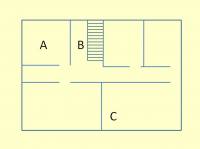Haunting hot spots

When a building is haunted, paranormal activity is not usually recorded everywhere. There are usually pronounced haunting ‘hot spots’ of activity.
For instance, in the floor plan above, of an imaginary haunted house, there are only three places on the ground floor where haunting activity regularly occurs. In room A an apparition has been seen. In the hall, B, the sound of footsteps are regularly heard while faint music is sometimes heard at C in the corner of the largest room. Though this is just an imaginary case, it is typical of many haunting reports. Not only are haunting activities confined to quite small areas of buildings but each usually always has the same kind of activity. Why other areas of the building are ‘haunt free’ is something of a mystery.
Identifying hot spots
It is likely that the existence of hot spots only became widely obvious when paranormal researchers started to organise vigils. When you need to plan where to station observers and equipment, you choose places most likely to produce something to record. Here are some examples from case reports on this website:
(1) “ The proprietor stated that several women in the bar area had said they had felt themselves being touched on their back or shoulders.” (from the The White Hart)
(2) “Graham explained that the most worrying phenomena occurred in bed. In January 1996 some furniture had been moved from one of the classrooms and stored in a corridor just outside Graham’s bedroom. There was a fireplace on Graham’s side of the wall adjoining the corridor. Since that time, on a number of occasions, something had either tried to pull Graham by the legs out of bed or pushed him and, on occasion, tried to strangle him. Sometimes he sensed some sort of presence approaching him, coming from the direction of the fireplace. His most frightening experience had occurred about a week before the interview. On that occasion he had seen a haze with eyes in it approaching his bed and then had his legs pulled in an attempt to drag him out of bed.” (from A School Haunting)
(3) “A sound of walking is heard on the landing floor from time to time. Bangs are also heard on a window upstairs. The sound of scratching has been heard on a particular window from time to time. On subsequent examination, scratch marks have been found where there were none before. ” (from Haunted Cottage)
(4) “In one location, the Tapestry Room (TR), there have been a number of quite specific experiences reported by people occupying the bed. The most impressive experience reported is the sound of a crying child, sometimes heard for as long as half an hour, from the TR bed. It is therefore possible to tie the experience to a specific, small locality - the TR bed itself.” (from The Haunted Bed)
In these examples, the bar area (1), bedroom, particularly the bed and fireplace (2), landing (3), and Tapestry Room, particularly the bed (4), would all seem likely hot spots. They have all produced multiple reports of activity. In each case, the activity was broadly similar, or even exactly the same, on each occasion.
Generally, other parts of a haunted building will produce just single reports of activity, or none at all. The problem with single reports is that they may be produced by psychological suggestion. Once a place is thought to be haunted, there is a tendency for witnesses to interpret any unexpected incident as part of the haunting.
If there have been multiple reports of similar activity from the same specific location within a building, particularly from independent witnesses who have no prior knowledge of the haunting, it is highly likely to be a hot spot. It is unlikely that several people experiencing the same thing, in the same place, at different times would be a coincidence.
Theories and discussion
On the face of it, there seems no obvious logical reason why a haunting should be confined to particular, often quite small, areas of a building. Does the agency behind the haunting ‘jump’ from hot spot to hot spot without affecting the areas in between? Is there something different about hot spots compared with the rest of the building?
In passing, another mystery of hauntings is, why are they generally confined to one particular building in the first place? In a row of terraced houses, why should one home be haunted while those on either side are not? The very peculiar geographical spread of haunting phenomena is surely some kind of clue to their origin.
Some researchers have suggested that certain places are considered haunted because they feel spooky. Factors known to increase this feeling are damp, cold, low lighting and things that look old. It would be worth checking such factors when comparing hot spots and other areas of a haunted building. The presence of a ‘cold spot’, however caused, may ironically result in a haunting ‘hot spot’!
Local circumstances can sometimes give rise to misperceptions, like shadows falling on walls, tree branches hitting windows, doors that open by themselves, and so on, which may give rise to reports of phenomena. Then there are factors like magnetically-induced hallucinations also to consider.
Certainly the existence of hot spots tends to favour natural over paranormal theories of hauntings. Paranormal theories need to account for why hauntings are apparently discontinuous for no obvious reason.